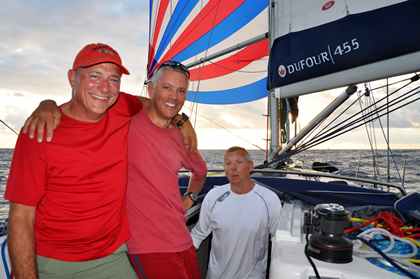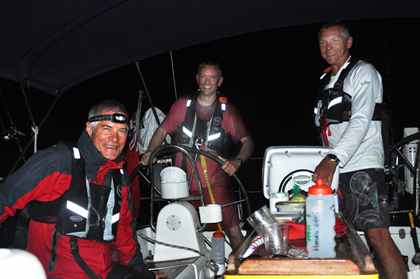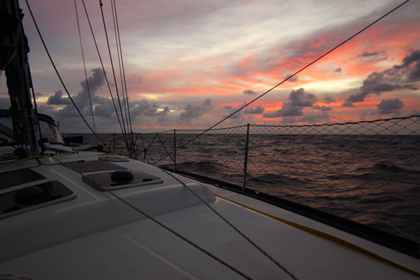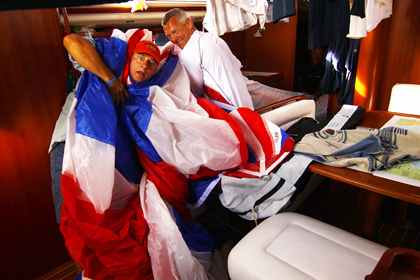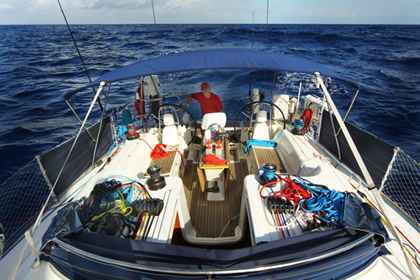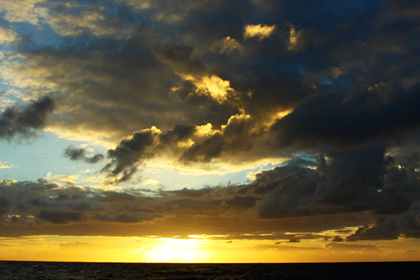Day 23 - What a Day!

Clearlake II
Graham van't Hoff
Sat 26 Nov 2011 12:51
|
Current position "19:49.4N
29:15.3W”. Too much to talk about yesterday. The day started with various
spinnaker challenges – resulting in it needing to be repacked down below deck as
you can see in the attached. The wind and weather steadily improved, as did
Graham’s sextant work, with a fix only 1.8 nm from where our friends the
satellites position us. You can see the daily shower routine – starts with sea
water, buckets thereof, and then a sparing amount of fresh water, just enough to
make the soap work and be able to rinse off – but otherwise all must be
preserved!
We’ve been doing well with
water consumption with good conservation (we use sea water for everything we
can, including cooking), resulting in the water-maker keeping us filled all the
time. Electricity is another matter, and we decided yesterday to drastically
reduce, with all equipment like VHF radio, PC, Radar, being shut-down unless
absolutely needed, and hand-steering (no autopilot) as much as possible. This
reduced our normal consumption level from 10-15 A to about 4 A (as we remarked,
it felt like that scene from Apollo 13 when they had to make the start sequence
for the lunar module work at a max of 2 A..!). The one other issue is emails
where we seem to only be getting some emails, so please resend those you may
have sent as they probably haven’t been received – guaranteed if you haven’t
received a reply.
All this great weather ended up with us raising the bimini to give us more
shade – the sun is becoming remorseless when it’s out from the clouds (we’re
level with south of the Sahara here) [I’m sure you can all relate to this in
London]. So we approached dinner very happy with ourselves. We looked to the
north and saw a stream of squalls and smugly welcomed the fact that we were
further south. At this time we took pictures of the fantastic sky, not realising
[derrr] that there was a reason for it looking so dramatic. As we looked astern
we saw a big blackness. Graham asked for opinions how long it would take to hit
us – votes were between 1 and 2 hours. But we concluded we could be wrong and
would do well to get the spinnaker down which took us the next 5-10 minutes.
Some 10 seconds (no kidding) from when we’d done that we were hit – the wind
went from 10 to 25-30 knots in about 3 seconds, with rain consistent with
standing under a full powered shower. The attached pic shows us about 5 mins
into this, all smiles [you can’t see the rain as it’s protected by the bimini].
James and Byron then retired to be rested for their 10 pm watch. Graham and
Chris were struggling to control the boat which had two reefs in a poled-out
genoa, but still a full mainsail – but were happy in the fact that this couldn’t
last long. The mainsail, with wind and waves was causing the boat to lurch from
gybing the main to backing the poled-out genoa – opening up the chance of
breaking either the pole or boom – so Graham was full on trying to keep control,
while Chris then tried to work out how to reduce sail (and get rid of the bimini
which was blocking all vision of what was going on). One and a half hours later
the squall finally dissipated – Graham described this as like riding a bucking
bronco for one and a half hours and practically had to be scraped off the deck
from exhaustion.
All told we had broken a block (pulley) on the mainsail, which was fixed
later on in the night, but nothing else. So exhaustion aside, it was a good
learning for us. Next time it’s spinnaker down, pole down and two reefs in both
sails at the first sign of trouble.
Otherwise we had a rather windless night (a pity one couldn’t have had the
mean speed between the two episodes but no such luck) and so today we’re off to
normal again. Progress wise, we’re now well west of the Cape Verdes – and it’s
pretty much west all the way now, about 1850 nm to go, having just covered 1000
nm since Las Palmas – so 35% of the way! When we look at the position reports
from this morning it’s tempting to be initially disappointed – our identical
boat is neck and neck with us, and the race version of our boat is 60 nm ahead.
But as at 4 am we had 1898 nm to go, and much of the fleet is between 1900 and
2100 nm to go; only the faster boats are in the 1800s and the very largest race
boats below that – an no-one knows at this stage who has used any engine (the
cruising boats are allowed to; they get penalised at the end); we haven’t used
ours at all. So all in all I think we’re doing great.
Thanks for reading!
|

